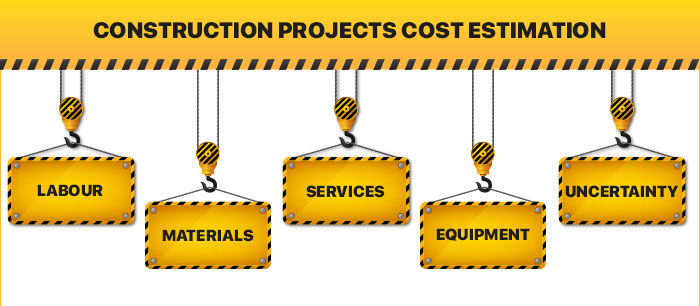
The Role of Cost Estimation Software in Modern Construction Projects
The construction sector is a multifaceted and continuously evolving field that necessitates precision, efficiency, and effective cooperation among diverse participants. Accurate cost estimation stands as a fundamental pillar for the success of construction projects. Historically, the process of estimating costs in construction was a laborious manual task susceptible to mistakes, resulting in budget overruns and project delays. Nonetheless, the introduction of modern cost estimation software has brought about a profound transformation in the construction industry, simplifying procedures, minimizing errors, and promoting collaboration among project stakeholders.
In this comprehensive guide, we will delve into the latest advancements in cost estimation software and examine how they are reshaping the construction industry. Additionally, we will identify SEO-rich keywords to ensure you derive the utmost benefit from this valuable information.
Understanding Cost Estimation in Construction
Before delving into the remarkable advancements in cost estimation software, it's essential to grasp the traditional challenges associated with estimating costs in construction. Historically, construction professionals relied heavily on manual calculations, spreadsheets, and historical data to estimate project costs. While this method could be reasonably accurate in some instances, it was plagued by several inherent problems.
Manual calculations were prone to human errors, resulting in inaccurate cost estimates. Moreover, as projects grew in complexity, the task of estimating costs became increasingly time-consuming and labor-intensive. Additionally, collaboration among project stakeholders was often hampered by the lack of a centralized and accessible platform for cost estimation.

The Evolution of Cost Estimation Software
The early adoption of cost estimation software marked a significant step forward in the construction industry's quest for more accurate and efficient cost estimation processes. These software solutions, while offering a digital alternative to manual calculations, came with their own set of challenges and limitations. Let's delve deeper into the evolution of cost estimation software and explore the journey from these initial offerings to the advanced tools we have today.
Manual Processes and Their Limitations
Before the advent of cost estimation software, cost estimators relied solely on manual processes. This included the use of spreadsheets, handwritten calculations, and extensive reference to historical project data to estimate construction costs. While estimators developed a keen sense of expertise over time, these manual methods had their inherent limitations:
Prone to Human Errors: Manual calculations were susceptible to human errors, such as typos, miscalculations, and omissions, which could lead to inaccurate cost estimates.
Time-Consuming: The manual estimation process was time-consuming, especially for complex projects. Estimators had to invest significant effort in performing calculations and data entry, which could delay project planning.
Data Accessibility Challenges: Accessing and retrieving relevant historical cost data could be challenging. Estimators often had to rely on fragmented or outdated information, making it difficult to produce precise estimates.
Limited Collaboration: Collaboration among project stakeholders was hampered by the lack of a centralized platform for cost estimation. This siloed approach could lead to communication gaps and misunderstandings.

Emergence of Early Cost Estimation Software
Recognizing these challenges, the construction industry began to explore software solutions designed to streamline the cost estimation process. These early cost estimation software programs represented a significant leap forward:
Digital Platform: Cost estimators could now perform their calculations in a digital environment, eliminating the need for manual calculations and handwritten spreadsheets.
Standardized Cost Databases: These software solutions often came equipped with standardized cost databases, providing estimators with a foundation of cost data to work from.
Increased Accuracy: While still requiring manual data entry, these software programs offered improved accuracy compared to purely manual methods.
However, despite these advantages, the early cost estimation software solutions had their own set of limitations:
Manual Data Entry: Estimators were still required to manually input a significant amount of data, which left room for data entry errors and inefficiencies.
Limited Integration: These early software solutions lacked robust integration capabilities with other construction project management tools, hindering the seamless flow of information across the project lifecycle.
The transition from manual processes to early cost estimation software represented a significant step forward, setting the stage for the more sophisticated and integrated solutions that would emerge in the modern era of construction project management.
The Modern Era of Cost Estimation Software
Fast forward to the present day, and modern cost estimation software has undergone a remarkable transformation. Today's software solutions have evolved to become powerful, user-friendly, and capable of addressing the multifaceted needs of the construction industry. These advancements have revolutionized the way construction professionals estimate costs and manage projects. In the sections that follow, we will delve into the latest innovations in cost estimation software and explore how they are reshaping the landscape of construction project management.

Integration with Building Information Modeling (BIM)
One of the most remarkable leaps forward in cost estimation software is its seamless integration with Building Information Modeling (BIM). BIM serves as a digital representation of a building's physical and functional attributes, providing a comprehensive and accurate overview of the entire project. The integration of cost estimation software with BIM allows estimators to effortlessly extract quantities and data directly from the model. This integration significantly reduces the risk of errors and ensures that estimates are based on the most up-to-date design changes.
This integration not only enhances collaboration but also mitigates the challenges associated with data synchronization between architects, engineers, and estimators. Any adjustments made to the BIM model are automatically reflected in the cost estimate, eliminating the need for manual updates, and reducing the likelihood of discrepancies.

Advanced-Data Analytics for Informed Insights
Modern cost estimation software harnesses advanced data analytics to enhance precision and provide more insightful insights. These software solutions can analyze historical cost data, market trends, and project-specific variables to generate more precise cost estimates. This data-driven approach empowers construction professionals to make better-informed decisions concerning project budgeting and resource allocation.
Moreover, cost estimation software equipped with advanced data analytics can simulate "what-if" scenarios. This capability enables project teams to explore various design options and their associated costs. As a result, stakeholders can make data-driven decisions that align with project objectives and budget constraints.
Real-Time Collaboration and Cloud-Based Solutions
Collaboration is the lifeblood of successful construction projects, and modern cost estimation software excels in this aspect. Cloud-based solutions grant project stakeholders the ability to access cost estimates, project data, and reports from anywhere with an internet connection. This real-time accessibility fosters seamless communication and collaboration among team members, regardless of their physical location.
Furthermore, cloud-based cost estimation software facilitates multiple users working on the same project concurrently, promoting transparency and eliminating version control issues. This collaborative environment empowers better decision-making and project coordination.
Mobile Accessibility for On-the-Go Professionals
Construction estimators and project managers are frequently on the move, visiting job sites, meeting with clients, and overseeing various aspects of projects. Recognizing this need, modern cost estimation software offers mobile accessibility through smartphone and tablet applications.
Mobile access enables users to view and update cost estimates, track project progress, and communicate with team members while in the field. This not only improves efficiency but also ensures that decision-makers always have access to up-to-date information, facilitating quicker response times and informed choices.

Machine Learning and AI Capabilities for Enhanced Accuracy
The integration of machine learning and artificial intelligence (AI) into cost estimation software represents a revolutionary advancement in accuracy and efficiency. Machine learning algorithms have the capacity to analyze extensive historical project data, identifying patterns and factors influencing construction costs. Consequently, estimators can generate more accurate estimates with reduced manual effort.
Additionally, AI-powered cost estimation software can learn from previous projects and adapt its algorithms to specific construction types or regions. This adaptive intelligence ensures that cost estimates are tailored to the unique characteristics of each project, further enhancing accuracy.
Enhanced Reporting and Visualization
Clear and concise reporting is essential in construction projects to effectively communicate cost estimates and project status to stakeholders. Modern cost estimation software offers enhanced reporting capabilities, enabling users to create detailed reports and visualizations that are easy to comprehend.
These reports can include comprehensive cost breakdowns, project timelines, and graphical representations of cost data. Such visualizations assist project teams and clients in grasping complex information swiftly, facilitating better decision-making and project oversight.

Conclusion: Empowering Construction Professionals for Success
In the rapidly evolving world of construction, staying competitive and efficient requires embracing the latest technological advancements. Modern cost estimation software has emerged as a game-changer, streamlining processes, reducing errors, and improving collaboration among project stakeholders. With integration with BIM, advanced data analytics, real-time collaboration, mobile accessibility, machine learning, and enhanced reporting, cost estimation software is empowering construction professionals to deliver projects on time and within budget.
As the construction landscape continues to transform, staying ahead of the curve by adopting innovative tools like these is not merely an option—it is a necessity for success. Modern cost estimation software has evolved from its manual roots to become an indispensable tool for construction projects. By harnessing the power of these advancements, construction professionals can streamline processes, reduce errors, and foster collaboration, ultimately delivering projects more efficiently and effectively in the modern age of construction.
Check https://app.bidlight.com for how BidLight can help you estimate your BIM model!